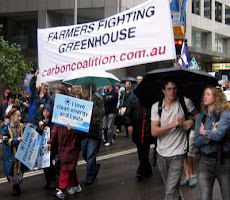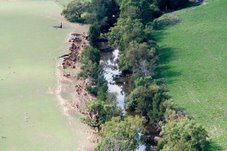An environmental conservation project that is being paraded as "a model for carbon farming" by the Government is damaging the cause of carbon farming. "It gives a free kick to those who complain that Carbon Farming is only about trees. Turning food-producing properties into national parks is not carbon farming, nor any form of farming," says Michael Kiely, Chairman of the Carbon Farming & Trading Association. The decision by R.M. Williams Agricultural Holdings to remove cattle from the 520,000ha Henbury Station in the Northern Territory and turn the property into a national park is trumpeted as "Leading the way in carbon farming". The property was bought for $13m (two-thirds of which was paid from Caring For Our Country funds) and the company plans to make the project pay through carbon credits for soil and vegetation "to sequestrate up to 1.5 million tonnes of carbon dioxide emissions per year for the next 10-15 years," says the Department of the Environment & Water. "The aim is to establish a model for generating biodiverse carbon credits to fund ongoing conservation management and to generate new sustainable income streams." These questions need to be answered: 1. How sustainable are the income streams? What happens in Year 16 when the revenue from carbon credits stops? Cattle cannot be reintroduced. 2. Does the absence of grazing animals remove the function of refreshing vegetation and disturbing the soil's surface to encourage new growth which helps avoid desertification. 3. Have any of the Minister's scientific advisers access to data on the increasing levels of biodiversity above and below the ground when soil carbon levels rise?
The A1FI scenario, considered in the most recent report from the Intergovernmental Panel on Climate Change (IPCC), represents the upper bound of predicted carbon emissions. The researchers, from the National Centre for Atmospheric Research, Colorado, and the Institute for Atmospheric and Climate Science, Zurich, created two hypothetical high carbon emission scenarios and compared their effects to the existing emission scenarios. The first scenario created, CurrentMix, assumed that global energy behaviour would remain constant but that the global population would rise to 11 billion by 2100. The increase in carbon emissions envisaged in the A1FI scenario would be doubled by the end of the century. The second scenario, AllCoal, was designed as a thought experiment to exceed all likely emissions for the remainder of the century. This scenario assumed that the global population would increase to 15 billion by 2100 and that demand for fuel sources would increase, with more demand placed on coal -- the fuel with the highest amount of carbon per unit of energy. This would result in four times the increase in carbon emissions envisaged in the A1FI scenario.
According to the researchers' computer simulations, the major differences between each scenario would begin to materialise towards the end of the 21st century. By 2100, the AllCoal and CurrentMix scenarios would produce a warming of over 12 Kelvin (K) in the Arctic regions, with global sea levels rising by 33 cm and 27 cm respectively due to the thermal expansion of the oceans. The A1FI scenario showed a 21 cm increase in sea levels; however the figures did not account for melting ice-sheets, which could increase sea levels by large amounts. The AllCoal scenario projected a complete loss of summer Arctic sea ice by 2070. Each of the scenarios showed the typical pattern of increased rainfall towards the poles and drying subtropics. For example, the AllCoal scenario showed a 30-80 per cent precipitation reduction in Southern Europe, Central America, and Southern Australia as well as increases of 50-200 per cent in the Arctic and Antarctic regions, Northern Canada and Siberia.
The increase in most regions' maximum temperatures went up by a factor of two in the AllCoal scenario; however some regions showed a considerably larger increase. In particular, the maximum summer temperatures in Northern Europe increased by 6-7 K by 2100. Lead author Dr Ben Sanderson said, "Our study considered a future in which fossil fuel availability is completely unrestricted and climate change is unmitigated, resulting in significant additional warming above the entire range of scenarios considered in the Fourth Assessment Report of the IPCC."
"This study showed us that the model behaves on a global scale largely as we would expect."
Story Source:
The above story is reprinted (with editorial adaptations by ScienceDaily staff) from materials provided by Institute of Physics.
Journal Reference:
- Benjamin M Sanderson et al. The response of the climate system to very high greenhouse gas emission scenarios. Environmental Research Letters, 6 034005, July 5, 2011 DOI: 10.1088/1748-9326/6/3/034005







